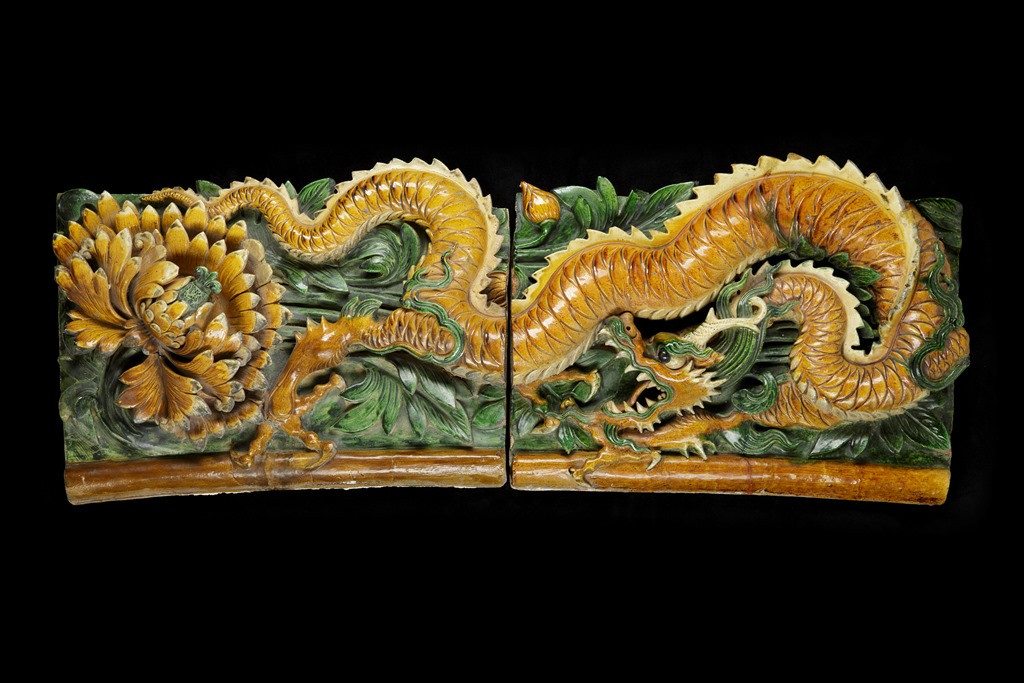
The new highlight at the Norton Museum of Art is centuries old and once guarded a Chinese temple from the natural elements.
On view through Oct. 2 are glazed dragon tiles dating back to the Ming Dynasty acquired by the museum earlier this year. Known as sancai or three-color tiles, the pieces are thought to have adorned the roof ridge of a temple’s main hall during the 15th or 16th century. They are exhibited as part of the museum’s Spotlight series, which is purposely minimalistic to allow for a more focused experience.
Considering they used to sit atop a building, the pair of tiles, here split into four panels, are in great shape. They feature five-clawed dragons – an imperial emblem – and a floral motif. They are portrayed quite menacingly with big black eyes, sharp teeth and long nails buried in the leafy surroundings. Their scaly elongated bodies in yellow ochre float above the lush, green vegetation while their white grown horns and thick green eyebrows suggest an acquired wisdom.
“Most of the mass-produced architectural elements produced today are not too expensive,” the Norton’s Curator of Chinese Art Laurie Barnes said over email. “However, replacements in the original Ming style would be very expensive.”
During the Ming dynasty, it was common to find tiles modeled after auspicious beasts and creatures decorating ridges and eaves. According to Chinese beliefs, rooftops acted as vessels of communication between heaven and earth. It follows that roof tiles such as these were created not just for protection against natural disasters, but to repel evil and attract good weather and harvest.
These vertical tiles known as fascia are believed to have come from Shanxi Province, where peonies equated wealth and dragons were thought to command the waters. These beasts could bring destruction through flooding or drought.
Famously known for blue-and-white porcelain wares, Ming China saw some of the most ambitious architecture. Once glazed ceramic roof tiles proved more weatherproof than wooden shingles, they were commissioned in large quantities to show off rank and status. Their position, size and sequence on the roof were determined by the prominence and scale of the building. Perhaps the finest example of tile usage during the period known as China’s golden age was the nine-story Porcelain Pagoda, which employed liuli-glazed titles.
Included in the exhibition is a porcelain jar (ca. 1488-1522) depicting the legend of zither player Yu Boya, whose search for inspiration tragically ended with him never playing again. Boya is credited with writing two famous Chinese melodies: “High Mountains” and “Flowing Water.” The bold display of turquoise, dark blue and purple enamels is characteristic of the fahua style, which combines low-fire glazes and features a prominent white.
While architectural fragments such as the roof tiles on view are not extremely rare to find, Barnes believes they have incalculable value.
“These are of extraordinary quality with regard to design.”
The Norton’s 11th annual Moon Festival in celebration of the museum’s collection of Chinese art will take place from noon to 5 p.m. Saturday, Sept. 17. Barnes will discuss the Ming panels as part of a series of events including docent tours of the Chinese collection, a concert of Chinese music by the Florida State University Chinese Music Ensemble, and a reception featuring tea and traditional Chinese mooncakes. The panels are on view until Oct. 2 at the museum, 1451 S. Olive Ave., West Palm Beach. Admission is free until December 2018 while the museum undergoes extensive renovations. For more information, call 561-832-5196 or visit www.norton.org.